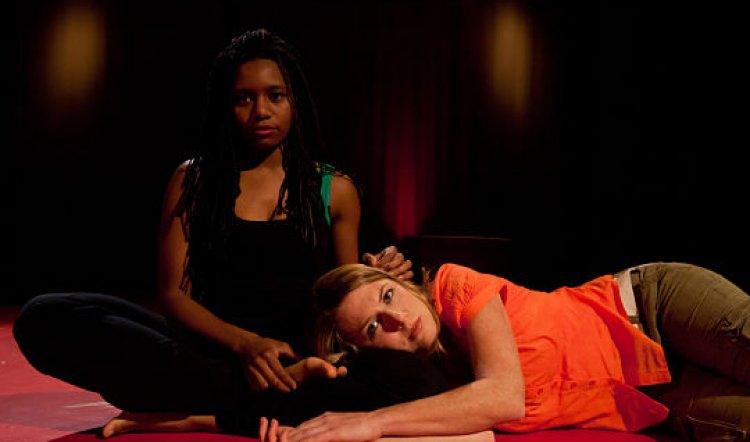
A QUIET NIGHT IN RANGOON
A QUIET NIGHT IN RANGOON, subtlenuance in The Spare Room at New Theatre; 18 August-10 September 2011. Photos by Zorica Purlija.
The gauntly beautiful face of Burma’s legally elected leader and most famous of many political prisoners, Aung San Suu Kyi, is – in the main – what westerners know of that brutally oppressed country. It’s a stark yet romantic image and symbolises the reality of a populace kept in poverty and isolation by a corrupt and powerful military.
Australian playwright Katie Pollock takes this starting point and sets down in Rangoon a young journalist, Piper, (Kathryn Schuback who’s been sent by her paper to do a puffy travel story. It’s a change from her usual beat of homewares and other fluff, but not too much of a stretch. Some factoids about the Shwedagon pagoda, a couple of quotes from picturesque Buddhist monks and a bit of tropical colour should do it, she thinks.
But it’s 2007 and the Burmese, led by their hitherto untouchable Buddhist monks, are rallying against the generals’ latest inept “policies”. Oblivious to what’s happening on the streets (she doesn’t do politics) Piper hires a young interpreter, Hello Kittie (Aileen Huynh) a ditzy blogger who dreams of fame but works as a teahouse waitress. Kittie can’t believe Piper’s willful obtuseness – which is comically similar to her own naivete – and each is blithely determined to make the other complicit in her ambitions.
Also unwittingly caught up in their adventures is an activist Buddhist monk, Mickey, (John Buencamino) and his friend and torture survivor Pluto (Barton Williams). And if you’re wondering, the code names are the kind of whistling-in-the-wind thing you do when opposing military might with little more than a prayer.
While Pollock’s play is grounded in history and the everyday it is quickly lifted out of docu-drama by bold theatricality. This is embodied, on a serious note, by an observer and commentator (Shauntelle Benjamin) who, as The Lake, is the seat of Rangoon’s dreams and nightmares. Aung San Suu Kyi’s crumbling home is visible on its shore yet it’s also where the military dumps the bodies of their victims.
A whimsical and very effective participant in the drama is The Net (Sonya Kerr) who (that?) is as helpful, obdurate, omniscient and scary as our universal digital umbilical cord is in real life. We laugh, but the chilly cramp in the guts of recognition makes the chortles uneasy. The final ingredient in the ironic turmoil of a Quiet Night is a serene-faced menace in green fatigues, The Major (Felino Dolloso). He represents all that is dangerous in a military machine that long ago forgot its duty to the people; and his apparent mildness only enhances that horror.

Pollock has observed and crafted her characters with considerable humour and insight. At the end of the one-act 90 minutes the characters have all earned one’s greater understanding, if not necessarily one's sympathy. The telling of the stories is rich and fascinating and the actors range from very good to settling in fast. Huynh, Schuback, Kerr and Buencamino have the best of the characterizations and do indeed make the most of their material.
A Quiet Night in Rangoon is in the literary (not movie) tradition of Turtle Beach and The Year of Living Dangerously. As such, while it shifts century and locale – Burma rather than Malaysia and Indonesia – it also offers a uniquely Australian perspective and sensibility on these countries and their political conflicts and is mostly absorbing.
The play and the actors are let down by the production’s creatives. The overall direction (by Paul Gilchrist) is so dull it made my teeth ache and on this evidence he has the comedic timing of a two-toed sloth. Between them he and set designer Chloe Lawrence-Hartcher have made the grave mistake of utilizing as much as possible of the sizable stage area. The consequence is actors spending an awful lot of dead time walking on and off and between scenes and locations.
As the preternaturally wise Micky says to Piper, of the first noble truth of the Buddhist path, “Pain is inevitable, suffering is optional.” The fuller context of this useful thought is: pain in life is inevitable but suffering is not. Pain is what the world does to you – suffering is what you do to yourself.
It did occur to me to wonder whether the playwright and actors might take it as their motto and be uplifted. Despite the above reservations: recommended.



